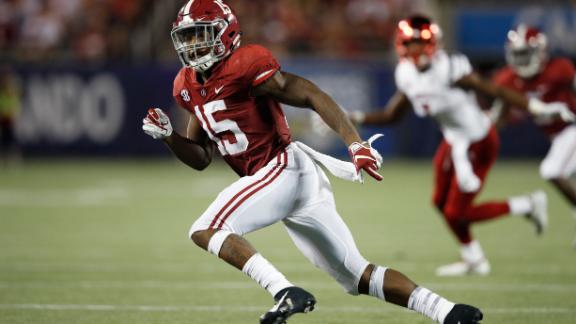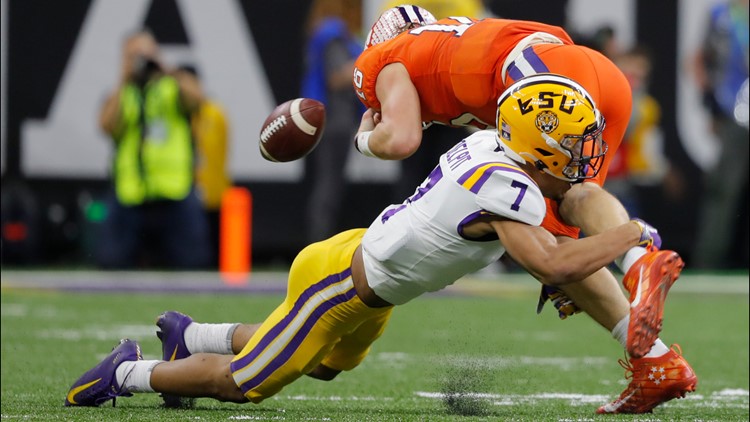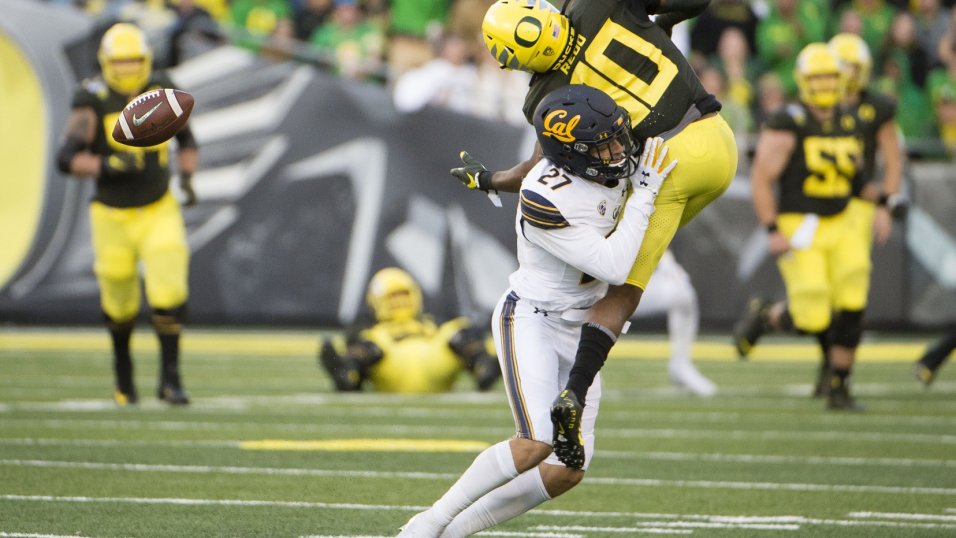After
covering wide receivers and cornerbacks a week ago, we’re onto the second week
of my NFL Draft Prospect Rankings. As I usually do, I have combined linebackers
and safeties into a single group. Partially since their roles overlap so much
in the modern NFL game, partially because there aren’t enough first round
talents at these positions for me to justify each having their own list.
As
always, listed in descending order of how I would select them.
Kenneth Murray, LB, Oklahoma
/cdn.vox-cdn.com/uploads/chorus_image/image/66225901/usa_today_13777246.0.jpg)
Murray
is a rare sort of linebacker. There are only a handful of players athletic
enough to cover the field sideline to sideline, and there are even fewer who
bring with it the punch to stuff a running back in a hole. He is freakishly
athletic and explosive, and he lays some absolutely devastating hits on ball
carriers in space. Each game he makes a couple truly beautiful plays in run
defense where he reads the play, scrapes to the hole, and fires downhill to
stuff the running back at the line of scrimmage.
Murray
is a bit raw in some areas, and it will be a couple years before he can really
live up to his potential as one of the best linebackers in football. He makes
some phenomenal plays sifting through traffic to get to the ball carrier, but
if an opposing lineman gets his hands on Murray the play is basically over. He
needs to get a lot better at playing through contact, either shedding the
blocker or driving him backwards to muddy up a running lane.
Coverage
skills are a crapshoot, as they usually are for young linebackers entering the
NFL. He certainly has the athletic ability to keep up in coverage, and he
showed flashes in college. He has good awareness on his zone drops, and he
alternated great plays in man coverage with some truly ugly missteps. One major
thing he has to learn is better recognition of play action, to take only a
single step forward before reacting backwards to cut off the passing lane. With
his explosive running and leaping ability, I think this development could very
easily be in the cards.
Murray
isn’t a perfect linebacker prospect, but he’s got a hell of an upside ahead of
him. Mostly he just needs reps. He needs to watch more plays develop in front
of him, and he needs to slam into more linemen coming downhill. When it all
clicks in place for him, his ferocity and closing speed could make him one of
the most feared players in the NFL. And even with the downside risk, I’d be
fine taking him in the top half of the first round.
Isaiah Simmons, LB/S, Clemson

I
have some concerns about Simmons, as you can see from where I have him rated,
but there is no questioning his physical gifts. There simply aren’t human beings
who are 6-4 and 238 pounds and who run a 4.39 forty yard dash with a 39 inch
vertical. The only thing more unique than his athleticism was the role he
played in Clemson’s defense. On any given play he was either a linebacker or a
slot corner or a deep safety or an edge rusher. Athleticism and versatility,
that is what Simmons brings to the table.
Of
course, playing a lot of positions only has so much value if a player isn’t actually
all that great at most of them. And that’s more or less what I saw from
Simmons. As a slot cornerback he was burned repeatedly in man coverage and had a habit of
drifting out of his zones. As a linebacker he gave up a lot of ground and got
pushed around by blockers. As a pass rusher he brought pretty much nothing to
the table but pure straight line speed.
The
Simmons that most people seem to be falling in love with is a bigger version of
Derwin James, a player who I loved coming out of Florida State in 2018. But the
player I saw when I watched him at Clemson was closer to another safety from
that draft class, Minkah Fitzpatrick. Specifically Fitzpatrick’s underwhelming
rookie year in Miami. With the Dolphins he was asked to do too much too quickly, and he
never really figured out his role, leading him to be passive and
hesitant as he bounced around the field. That's what I saw a lot from Simmons, a player who rarely seemed comfortable enough with the reads he was making to let himself loose.
Of
course after being traded to Pittsburgh early last season, Fitpatrick thrived in a more traditional role as a deep safety, earning first team All
Pro honors at the end of the season. And this is what makes Simmons
still worth a selection in the mid-to-late first round. Rather than stifling him by
asking him to do way too much, keep it simple and let his athleticism come
through with aggression. When he does fire downhill he makes plays that no one
else can make, using his closing speed and length to feel like he’s covering
the entire field in a single moment.
So
what position is best for Simmons? I’m not entirely sure, and that gives me
some pause (I faced a similar dilemma with Jabrill Peppers a few years ago, and
that comparison certainly scares me). If I had to pick
one position, I would likely follow the Fitzpatrick model and stick him at deep
safety. This likely has the highest learning curve of any position, since it was
the one he played the least in college, but it has the highest ceiling as well.
With his length and athleticism he could erase huge chunks of the field in
coverage, if he ever develops the instincts needed to utilize his gifts.
Antoine Winfield Jr, S, Minnesota

I’m
not going to pretend I can be impartial about a player named Antoine Winfield.
His father is one of my favorite players of all time, and there are definitely
echoes of the elder Winfield’s style in the younger’s game. He plays a different
position, safety rather than cornerback, but he brings a similar combination of
physicality and versatility to the table, even if he applies it in a different
way.
Winfield
spent most of his time at Minnesota playing in a deep zone, and I think that’s
where he’ll find his best fit in the NFL. He didn’t show a lot of range from
sideline to sideline, but his 4.46 forty and his flashes of closing speed on
the field suggest that he could develop more of this, once he gets better at
play recognition. And his ball skills are the best in the class. He attacks the
football in the air, and he makes plays through traffic to take the ball away
from the offense.
Winfield
does enough other things well to make him worthy of a pick late in the first
round. He fires downhill aggressively in run support, though he has a habit of
getting caught up in traffic and probably shouldn’t spend too much time playing
in the box. He’s a sure tackler, even if he occasionally gets dragged an extra
yard or two. He plays bigger than his 5-9 stature, but this will still be an
issue. He’s strong enough to disrupt
bigger receivers and tight ends on their routes, but I do worry some about him
in man coverage. Fortunately in the right system he won’t have to play much of
this, and he’ll be able to develop into a true ball-hawking safety in the deep
middle.
Xavier McKinney, S, Alabama

You
know what you’re going to get when you draft McKinney. There isn’t much
downside here, and not a lot of upside either. He’s a very smart player who
makes excellent reads and is always in position. He’s also a subpar athlete who
doesn’t cover a lot of ground and makes very few spectacular plays. He’ll be a
decent starter from the moment he enters the league, and he’ll never be much
more than that.
McKinney’s
greatest strength is in man coverage. He excels when lined up over a receiver
in the slot, able to match them break for break as they try to get open on
underneath routes. I’m a bit worried what will happen when he faces a vertical
route, but playing on the inside he’ll at least be in better position to have
help from a safety behind him. He’s good enough in coverage that if he was a
better athlete I would think about him moving to cornerback full time, but as
it is I think defenses won’t want him matched up on an island against most NFL
receivers.
Apart
from that, he really doesn’t do anything special. He can deliver some good
sticks on tackles in tight windows, but he’s a poor tackler in space, playing out
of control and often just lunging past the ball carrier. He doesn’t cover much
ground laterally in a deep zone, though he makes up for it somewhat by usually
making smart reads and getting early breaks on the ball. He can do a variety of
things in the NFL, but he won’t really excel at them. Still, his reliability
makes him worth a second round pick.
Grant Delpit, S, LSU

We
didn’t get testing numbers on Delpit, but we really don’t need them. He’s fast,
and he’s explosive, and he is pretty much always putting those skills on
display on the field. I criticized Simmons for not being aggressive enough, but
Delpit has the opposite problem. He fires out of a cannon on every single play,
and seemingly in every single direction. Sometimes it works out and it’s a stunning,
explosive play. Other times he runs in completely the wrong direction and lets
the defense break down behind him.
It
feels like Delpit is on every part of the field at once, but what he does in
those parts of the field leaves more than a little to be desired. When he hits
someone square, he can deliver a blow that knocks them backwards in time. But
more often than not he goes for this blow and gets nothing but air, as a single
cut leaves him skidding past across the ground. He’s a dreadful tackler, and he
can’t be relied on in run support. Which makes it frustrating that he plays
like a run stuffing, lane filling safety.
Delpit
is going to need to change his mentality in the NFL. With his length, his ball
skills, and his speed, he has all the makings of a terror in a deep zone. But
he needs to figure out how to read plays from this position, and how to take
proper angles to cut receivers off at the sideline. He also needs to develop in
man coverage, but he has the talent to do this as well. He has the talent to do
a lot of things, and as many flaws as there are in his game, I can’t see
letting him slide far into the second round before taking him on the off chance
he can figure it out.
Patrick Queen, LB, LSU

Queen
is another athletic, frenetic linebacker. A clear step down from someone as
well rounded as Murray, but still a player with some upside to develop into an
above average starter. In terms of covering ground he’s as good as any
linebacker I can remember watching. There is never a play where he can just be
ignored because he’s on the backside, and nothing to the edge that he can’t run
down.
Queen
covers so much ground that he can often get away with taking a path other than
the most direct one to the football. He can loop all the way around blockers
and then cut back to make a play on the inside. Which is fortunate, because if
he can’t go around a blocker, there’s nothing he can do about him. At 229
pounds he is small for a linebacker, and he gets pushed around by linemen
moving downfield to him. He’s pretty good at disengaging after initial contact,
but initial contact has a habit of knocking him backwards a couple of yards.
The
other big concern I have with Queen is in pass coverage. Like Murray he has all
the physical tools he needs to develop in that area, but unlike Murray there
was never really a moment where he showed that he understood the concepts
behind pass coverage. Mostly he just stood there, in a zone without much depth
and without even a pretense of looking for a wide receiver. Obviously this is
mostly mental, and he can pick up more of these skills after some time in the
NFL. But it’s bad enough that I don’t think he can be allowed to learn on the
field, at least not as anything more than a first and second down specialist. It
will take a couple years to get anything from Queen, and even then he will be
limited somewhat by his lack of physicality, which is why I think his value is
a better fit in the latter half of the second round.
Ashtyn Davis, S, Cal

If
you miss out on McKinney but still want a reliable if unspectacular safety on
the back end, Davis is a good option once the third round rolls around. He
brings a lot of experience playing in a deep zone, and he knows how to read
routes developing underneath him. His positioning is usually excellent, and he
rarely makes mental mistakes, which is always a good thing to have from the
last line of defense.
Apart
from that, there’s not much to say about Davis. He doesn’t cover a lot of
ground, either moving laterally to cut off routes or coming up in run support.
He’s a consistent tackler in space, but he usually takes the most conservative
angle possible, sacrificing a couple extra yards each time. And most notably,
he lacks McKinney’s gifts in man coverage. He’s capable of playing that role in
a defense, but you wouldn’t want to ask him to do it on every snap.
The
one thing I will say about Davis is that his ball skills are sensational. He
goes up high, and he always times his leaps perfectly. He tracks the ball well
in the air, and he has soft hands to come down with the takeaway. He’ll
probably end up putting up decent interception numbers in the NFL, making up
somewhat for the sheer number of plays his lack of athleticism prevents him
from reaching.



/cdn.vox-cdn.com/uploads/chorus_image/image/66525083/1174201635.jpg.0.jpg)



